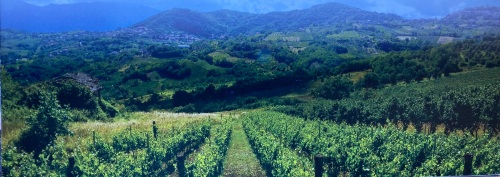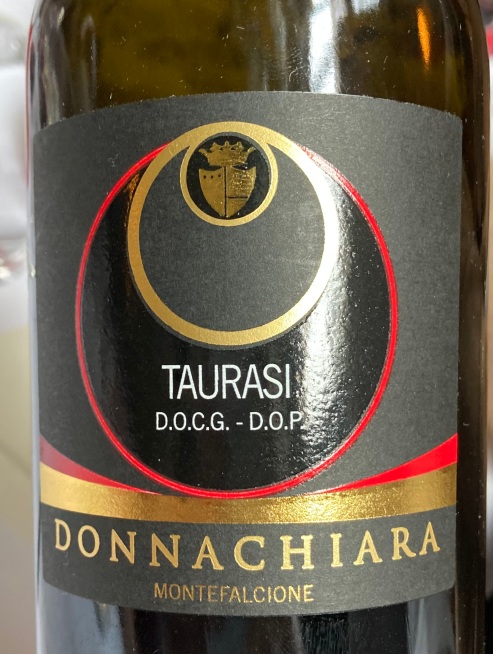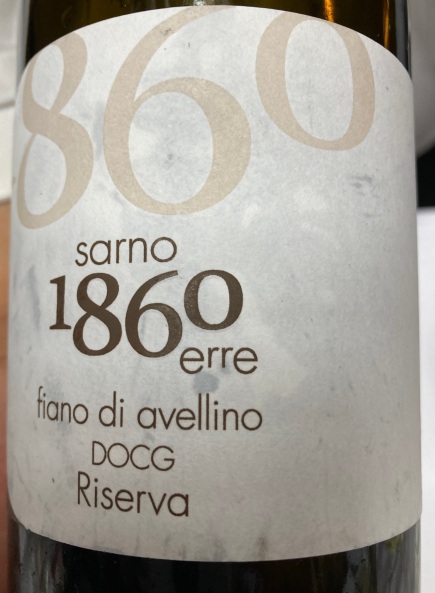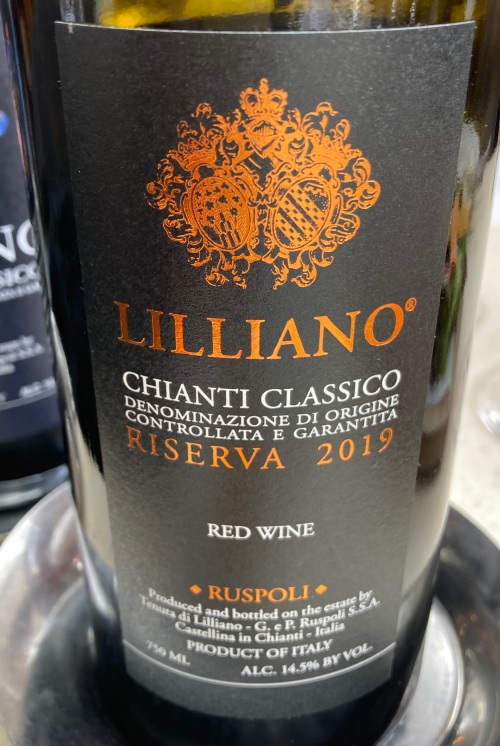Last week I was invited to attend a masterclass on the wines of Irpinia at Il Gattopardo restaurant in NYC by the Irpinia Consorzio Tutela Vini. Teresa Bruno Di Petilia, President, and Ilaria Petitto, the Vice President of the Conzorzio, were there. They said the goal of these events is to familiarize the wine drinking public with Irpinia and make their excellent wines better known.
The speaker was Susannah Gold of Vigneto Communications who did an excellent job of sharing her knowledge of the wines of Irpinia through her talk and slide presentation. I wrote about the 6 white wines in a previous blog and this time I will deal with the 6 red wines.
Irpinia Aglianico
There are 3 biotypes of Aglianico: Taurasi, Vulture and Taburno. Susannah pointed out the Aglianico has an uncle-nephew relationship to Syrah.
 Aglianico is an ancient grape variety. In Italy, Aglianico was first planted near modern day Pozzuoli and from there it spread to other parts of Campania. Pliny the Elder (d.79AD) wrote about it in his Natural History. The Aglianico grape prefers volcanic soil and grows at altitudes of 300 to 500 meters. Aglianico is also used as a blending grape in Campania. It is at its best in Irpinia.
Aglianico is an ancient grape variety. In Italy, Aglianico was first planted near modern day Pozzuoli and from there it spread to other parts of Campania. Pliny the Elder (d.79AD) wrote about it in his Natural History. The Aglianico grape prefers volcanic soil and grows at altitudes of 300 to 500 meters. Aglianico is also used as a blending grape in Campania. It is at its best in Irpinia.
 Irpinia Aglianico was granted DOC in 2005. It must contain 85% Aglianico and 15% other red grapes.
Irpinia Aglianico was granted DOC in 2005. It must contain 85% Aglianico and 15% other red grapes.
Irpinia Campi Taurasini is a sub region of the Irpinia DOC of central Campania. The classification applies to wines made from the Aglianico grape on the Campi Taurasi, the Taurasian Fields. This territory is the same as Taurasi DOCG. Campi Taurasini means “little Taurasi fields.” While Taurasi Riserva DOGG is aged for 3 years in oak barrels and can age for many years, the Taurasini spends just one year in oak before bottling. It is a wine that is made to be drunk young but still has aging potential. Irpinia Aglianico and Campi Taurasini in particular are less-full bodied, less structured and less expensive than Taurasi.
There are many who believe that the three great grape varieties in Italy are Nebbiolo, Sangiovese and Aglianico. Wines made from the Aglianico grape are full-bodied with good fruit, tannins, and hints of blackberries, leather and smoke.
Irpinia Aglianico Wines
 Nativ, Irpinia Aglianico “Rue Dell’Inchiostro” Campania Aglianico DOC, 2020 made from 100% Aglianico grown at 450 to 550 meters. There are 15 hectares of wine, the soil is mostly volcanic with clay and limestone, rich in minerals. There is a trellis training system with spurred cordon in the new vineyards. Harvest is in the beginning of November. There is a pre-soaking at a controlled temperature. Fermentation soaking with continuous pumping over and punching downpour for about 10 days. Fermentation starts with the addition of selected yeasts, malolactic fermentation takes place. Refining in steel silos. The wine ages in bottle before release. The wine has hints of red berries, cherry and a touch of spice. The winery is located in Paternopoli.
Nativ, Irpinia Aglianico “Rue Dell’Inchiostro” Campania Aglianico DOC, 2020 made from 100% Aglianico grown at 450 to 550 meters. There are 15 hectares of wine, the soil is mostly volcanic with clay and limestone, rich in minerals. There is a trellis training system with spurred cordon in the new vineyards. Harvest is in the beginning of November. There is a pre-soaking at a controlled temperature. Fermentation soaking with continuous pumping over and punching downpour for about 10 days. Fermentation starts with the addition of selected yeasts, malolactic fermentation takes place. Refining in steel silos. The wine ages in bottle before release. The wine has hints of red berries, cherry and a touch of spice. The winery is located in Paternopoli.
 Macchie Santa Maria, Irpinia Aglianico DOC, 2018 made from 15 year old vines at 400 to 450 meters. The training system is cordon. The soil is of a medium mixing tending toward stony clay. Exposure is southeast. Fermentation is 8 to 12 days in stainless steel tanks. Aging is for 12 months in French oak barriques. The wine has hints of black cherry, plum, spice and a hint of tobacco. The company is based in the town of Montemiletto
Macchie Santa Maria, Irpinia Aglianico DOC, 2018 made from 15 year old vines at 400 to 450 meters. The training system is cordon. The soil is of a medium mixing tending toward stony clay. Exposure is southeast. Fermentation is 8 to 12 days in stainless steel tanks. Aging is for 12 months in French oak barriques. The wine has hints of black cherry, plum, spice and a hint of tobacco. The company is based in the town of Montemiletto
 Ponterotto, Irpinia Aglianico DOC 2018 made from 100% Aglianico at 350 to 400 meters. The soil is clay and limestone and harvest is the first 10 days of November. Classic vinification in tanks, long maceration with the skins at a controlled temperature. The wine has hints of blackberries, spice with a touch of tobacco and a balsamic note.
Ponterotto, Irpinia Aglianico DOC 2018 made from 100% Aglianico at 350 to 400 meters. The soil is clay and limestone and harvest is the first 10 days of November. Classic vinification in tanks, long maceration with the skins at a controlled temperature. The wine has hints of blackberries, spice with a touch of tobacco and a balsamic note.
Taurasi
 Aglianico reaches its highest expression in the form of Taurasi, one of Italy’s great red wines, which can age for many years.
Aglianico reaches its highest expression in the form of Taurasi, one of Italy’s great red wines, which can age for many years.
The Taurasi DOCG was formed in 1993 and was southern Italy’s first DOCG. Taurasi is a medieval city located within the larger Iripinia DOC and within the province of Avellino, Taurasi’s name comes from taurus, the mythical bull that was the symbol for the ancient Samnite (pre-Roman) occupants.
Taurasi DOCG and Taurasi Riserva DOCG by law must be 85% Aglianico but most producers make it with 100% Aglianico. Taurasi must age for 3 years before release and have a minimum of 12% alcohol. At least one of the 3 years must be in oak barrels. The Riserva must be aged for at least 4 years of which 18 months must be in oak barrels. 12.5% is the minimum alcohol.
There are 17 communes where Taurasi is produced and they cover different soils, vineyard altitudes and microclimates.
 Ilaria Petitto CEO of Donnachiara Winery and Vice President of the Consorzio di Tutela dei Vini dell’Irpinia spoke about the winery and the wines. The winery is located in Montefalcione in the Irpinia area near Avellino. The modern winery was completed in 2005 but the vineyards have been in the family for over 150 years. Ilaria’s mother, Chiara Petitto, is a big supporter of her work in the winery, which is named after her mother’s grandmother whom everyone called “Donna” Chiara as a sign of respect.
Ilaria Petitto CEO of Donnachiara Winery and Vice President of the Consorzio di Tutela dei Vini dell’Irpinia spoke about the winery and the wines. The winery is located in Montefalcione in the Irpinia area near Avellino. The modern winery was completed in 2005 but the vineyards have been in the family for over 150 years. Ilaria’s mother, Chiara Petitto, is a big supporter of her work in the winery, which is named after her mother’s grandmother whom everyone called “Donna” Chiara as a sign of respect.
 Donnachiara, Taurasi DOCG 2019 Made from 100% Aglianico. The soil is clay and volcanic. Training system is guyot. There are 4,000 plants per hectare and harvest takes place the first week of September. The wine is aged for 12 months in 225-liter French barriques and remains in the bottle for another 24 months before release. The wine has hints of blackberry, plum, cherry and a touch of cacao. The use of barrique is subtle and does not mask the character of the wine. This is a big complex wine with berry aromas and flavors, hints of cherry, plum, and a touch of cacao and coffee.
Donnachiara, Taurasi DOCG 2019 Made from 100% Aglianico. The soil is clay and volcanic. Training system is guyot. There are 4,000 plants per hectare and harvest takes place the first week of September. The wine is aged for 12 months in 225-liter French barriques and remains in the bottle for another 24 months before release. The wine has hints of blackberry, plum, cherry and a touch of cacao. The use of barrique is subtle and does not mask the character of the wine. This is a big complex wine with berry aromas and flavors, hints of cherry, plum, and a touch of cacao and coffee.
 Feudi Di San Gregorio Taurasi DOCG 2017 made from 100% Aglianico in uncontaminated volcanic soil. The vines are 20 to 25 years old. Vineyards are at 1,000 to 1,600 ft with a southern and western exposure. Soil is ash and fallen pumice and in the subsoil deep layers of silty sand. Harvest is manual. Fermentation and maceration is in stainless steel tanks, at a controlled temperature for about 3 weeks. The wine is aged for about 18 months in medium toasted French barriques and 9 months in the bottle before release. The wine has hints of cherry, cinnamon, nutmeg, anise and more than a note of vanilla. The winery is in Sorbo Serpico.
Feudi Di San Gregorio Taurasi DOCG 2017 made from 100% Aglianico in uncontaminated volcanic soil. The vines are 20 to 25 years old. Vineyards are at 1,000 to 1,600 ft with a southern and western exposure. Soil is ash and fallen pumice and in the subsoil deep layers of silty sand. Harvest is manual. Fermentation and maceration is in stainless steel tanks, at a controlled temperature for about 3 weeks. The wine is aged for about 18 months in medium toasted French barriques and 9 months in the bottle before release. The wine has hints of cherry, cinnamon, nutmeg, anise and more than a note of vanilla. The winery is in Sorbo Serpico.
 Fratelli Addimanda Vignaioli in Taurasi “Starse” Taurasi DOCG 2014 made from 100% Aglianico. The vineyards are at 350 to 400 meters and the exposure is east-west. The soil is clay calcareous and the training system is cordon speronato. There are 4,500 plants per hectare. Manual harvest with a selection, is from the end of October to the beginning of September. There is another selection of grapes in the cellar. Fermentation with a long maceration of the skins for about 25 days. After malolactic fermentation the wine matures in barriques and tonneaux of new French oak for 14 to 18 months depending on the vintage. The wine has hints of red fruit, dried flowers, tobacco, liquorice, pepper and a note of vanilla.
Fratelli Addimanda Vignaioli in Taurasi “Starse” Taurasi DOCG 2014 made from 100% Aglianico. The vineyards are at 350 to 400 meters and the exposure is east-west. The soil is clay calcareous and the training system is cordon speronato. There are 4,500 plants per hectare. Manual harvest with a selection, is from the end of October to the beginning of September. There is another selection of grapes in the cellar. Fermentation with a long maceration of the skins for about 25 days. After malolactic fermentation the wine matures in barriques and tonneaux of new French oak for 14 to 18 months depending on the vintage. The wine has hints of red fruit, dried flowers, tobacco, liquorice, pepper and a note of vanilla.
After the tasting there was an excellent buffet prepared by Chef Vito Il Gattopardo.
Next Time Gruppo Italiano Table Talks/ Chapter 16 Irpinia We are Waiting for You

 Teresa Bruno Di Petilia, President, and Ilaria Petitto, the Vice President of the Conzorzio Tutela Vini d’Irpinia invited me to a tasting of the wines of Irpinia at Il Gattopardo NYC. The event was called “Spectacular Irpinia.”
Teresa Bruno Di Petilia, President, and Ilaria Petitto, the Vice President of the Conzorzio Tutela Vini d’Irpinia invited me to a tasting of the wines of Irpinia at Il Gattopardo NYC. The event was called “Spectacular Irpinia.” The speaker was Susannah Gold, who did an excellent job of sharing her knowledge of the wines of Irpinia through her talk and slide presentation. We tasted 6 white wines and 6 reds. This blog will deal with the 6 whites.
The speaker was Susannah Gold, who did an excellent job of sharing her knowledge of the wines of Irpinia through her talk and slide presentation. We tasted 6 white wines and 6 reds. This blog will deal with the 6 whites. Fiano Di Avellino “Alimata” 2018.
Fiano Di Avellino “Alimata” 2018. Fiano Di Avellino “Eclissi” 2018 Case d’Alto made from 100% Fiano di Avellino from a 2 hectare vineyard in Grottaminarda. The soil is clay and calcareous. The wine has hints of apple, yellow fruit, lemon and a note of fresh hazelnuts
Fiano Di Avellino “Eclissi” 2018 Case d’Alto made from 100% Fiano di Avellino from a 2 hectare vineyard in Grottaminarda. The soil is clay and calcareous. The wine has hints of apple, yellow fruit, lemon and a note of fresh hazelnuts Fiano Di Avellino Riserva
Fiano Di Avellino Riserva Greco di Tufo 2021 Historia Antiqua made from 100% Fiano di Avellino. The winery was started in the 1990’s and and was at first a Consortium.
Greco di Tufo 2021 Historia Antiqua made from 100% Fiano di Avellino. The winery was started in the 1990’s and and was at first a Consortium. Greco di Tufo ‘Quattro Venti’ Riserva 2020 Petilia Made from 100% Fiano di Avellino. The vineyards are in Chianche, locality of Sant’Andrea (Altavilla). The vineyards are at 600 meters, the exposure is south/east and there are 4,000 plants per hectare. The soil is clayey, volcanic, and rich in minerals with a sumptuous subsoil and the training system is espalier with guyot pruning. The vines are 20 years old. Harvest takes place the second week of October. There is ultra soft pressing with whole grapes and fermentation in steel tanks at a controlled temperature. Malolactic fermentation does not take place. The wine has citrus notes, hints of almonds, lemon blossoms and quince.
Greco di Tufo ‘Quattro Venti’ Riserva 2020 Petilia Made from 100% Fiano di Avellino. The vineyards are in Chianche, locality of Sant’Andrea (Altavilla). The vineyards are at 600 meters, the exposure is south/east and there are 4,000 plants per hectare. The soil is clayey, volcanic, and rich in minerals with a sumptuous subsoil and the training system is espalier with guyot pruning. The vines are 20 years old. Harvest takes place the second week of October. There is ultra soft pressing with whole grapes and fermentation in steel tanks at a controlled temperature. Malolactic fermentation does not take place. The wine has citrus notes, hints of almonds, lemon blossoms and quince. Greco di Tufo ‘Vigna Laure” 2020 Riserva Cantina Di Marzo Made from100% Greco di Tufo from a 5 hectare vineyard with a south-southwest exposure. Vines were planted in 2008 and 2010. Laure vineyard is on a rock which is on top of an old sulphur mine. The grapes are hand harvested toward the end of October. Destemming takes place
Greco di Tufo ‘Vigna Laure” 2020 Riserva Cantina Di Marzo Made from100% Greco di Tufo from a 5 hectare vineyard with a south-southwest exposure. Vines were planted in 2008 and 2010. Laure vineyard is on a rock which is on top of an old sulphur mine. The grapes are hand harvested toward the end of October. Destemming takes place

 Chianti Classico 2020 DOCG made from 90% Sangiovese, 5% Colorino and 5% Merlot. After the quality-selected clusters are destemmed and pressed, the must is fermented and macerated in stainless steel for 18-20 days at a controlled temperature with programmed punch downs and daily pumpovers. Maceration fermentation takes place in concrete and small stainless steel tanks at a controlled temperature for 18-20 days depending on the vintage. The wine ages for about 12 to 14 months partly in large casks of French oak and partly in concrete. After maturation, the final blend is assembled, bottled and aged in glass for a minimum of 3 months. This is a wine with hints of red fruit, cherry, violets and a touch of cassis.
Chianti Classico 2020 DOCG made from 90% Sangiovese, 5% Colorino and 5% Merlot. After the quality-selected clusters are destemmed and pressed, the must is fermented and macerated in stainless steel for 18-20 days at a controlled temperature with programmed punch downs and daily pumpovers. Maceration fermentation takes place in concrete and small stainless steel tanks at a controlled temperature for 18-20 days depending on the vintage. The wine ages for about 12 to 14 months partly in large casks of French oak and partly in concrete. After maturation, the final blend is assembled, bottled and aged in glass for a minimum of 3 months. This is a wine with hints of red fruit, cherry, violets and a touch of cassis. Chianti Classico Riserva 2019 made from 95% Sangiovese and 5% Merlot from the first selection. After a careful selection the grapes undergo soft pressing and destalking. During fermentation the must is pumped over with plunging of the cap on a daily basis. Maceration lasts for 21 to 25 days depending on the vintage. Malolactic fermentation takes place in stainless steel tanks. The wine ages in large casks of French oak 28 to 34HL. The final blend is assembled and the wine ages in glass a minimum of 6 months. The wine has hints of cherry, cassis, violets, and a touch of spice.
Chianti Classico Riserva 2019 made from 95% Sangiovese and 5% Merlot from the first selection. After a careful selection the grapes undergo soft pressing and destalking. During fermentation the must is pumped over with plunging of the cap on a daily basis. Maceration lasts for 21 to 25 days depending on the vintage. Malolactic fermentation takes place in stainless steel tanks. The wine ages in large casks of French oak 28 to 34HL. The final blend is assembled and the wine ages in glass a minimum of 6 months. The wine has hints of cherry, cassis, violets, and a touch of spice. Chianti Classico Grand Selezione DOCG 2018 made from 90% Sangiovese, 5% Colorino and 5% Merlot from grapes grown and selected from the Le Piagge and La Casina vineyards where the soil is calcareous clay. After a careful selection the grapes undergo a soft crushing and destemming. During fermentation the must is pumped over with plunging of the cap on a daily basis. Maceration is for 25 days depending on the vintage. Malolactic fermentation is in stainless steel tanks. The wine matures for 15 months in French oak barrels of 28 and 34HL and in tonneaux (500 liters). The wine is blended, bottled and ages for a minimum of 6 months. This is a full bodied wine with hints of red fruit, floral notes, cherry, plum and a touch of violets.
Chianti Classico Grand Selezione DOCG 2018 made from 90% Sangiovese, 5% Colorino and 5% Merlot from grapes grown and selected from the Le Piagge and La Casina vineyards where the soil is calcareous clay. After a careful selection the grapes undergo a soft crushing and destemming. During fermentation the must is pumped over with plunging of the cap on a daily basis. Maceration is for 25 days depending on the vintage. Malolactic fermentation is in stainless steel tanks. The wine matures for 15 months in French oak barrels of 28 and 34HL and in tonneaux (500 liters). The wine is blended, bottled and ages for a minimum of 6 months. This is a full bodied wine with hints of red fruit, floral notes, cherry, plum and a touch of violets. Anagallis Colli Della Toscana Centrale IGT made from 50% Cabernet 40% Merlot and 10% Petit Verdot. After a careful selection in the vineyard the grapes undergo soft crushing and destalking before fermenting in 59 hl temperature controlled stainless steel tanks. Maceration is for 25 days and malolactic fermentation is in
Anagallis Colli Della Toscana Centrale IGT made from 50% Cabernet 40% Merlot and 10% Petit Verdot. After a careful selection in the vineyard the grapes undergo soft crushing and destalking before fermenting in 59 hl temperature controlled stainless steel tanks. Maceration is for 25 days and malolactic fermentation is in Tony also opened a Chardonnay from Paolo & Noemia d Amico winery, Calanchi Di Vaiano IGP Lazio made from 100% Chardonnay from vineyards overlooking Umbria at 450 meters. Fermentation is in stainless steel and the wine is aged in stainless steel for about 3 months. The wine has hints of citrus fruit and apricot with a touch of white pepper and a floral note. It was very refreshing in more ways than one to taste an unoaked Chardonnay
Tony also opened a Chardonnay from Paolo & Noemia d Amico winery, Calanchi Di Vaiano IGP Lazio made from 100% Chardonnay from vineyards overlooking Umbria at 450 meters. Fermentation is in stainless steel and the wine is aged in stainless steel for about 3 months. The wine has hints of citrus fruit and apricot with a touch of white pepper and a floral note. It was very refreshing in more ways than one to taste an unoaked Chardonnay